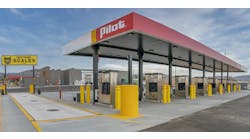Back-and-forth dialogues are making trucking better
The mission of the North American Council for Freight Efficiency is, as the name implies, to help the trucking industry improve its efficiency. As you know, we do that in a variety of ways. One of the things the team at NACFE really likes is sharing what we’ve learned with others. We do this by participating in webinars, speaking at conventions, and giving presentations to interested parties.
In sharing our knowledge, we would like to think that we are helping the industry get to a greener future. Last year, we gave a record number of presentations—some in person, others virtually.
Here’s the interesting thing I noticed from all these presentations. Audience members were not the only ones learning; the NACFE staff was learning, too. Whenever we engage in dialogue with the industry—and I consider these presentations to be dialogues—we learn. Quite often, what we learn is something about how a technology performed in the real world. Or we learn about how a fleet overcame an obstacle in trying to deploy new technology in its operations. Or we learn about changes a manufacturer is making to a product to improve its durability, efficiency, or to allow fleets to achieve better return on investment.
All of this new information allows us to refine our presentations and share the latest best practices with the industry. It also helps inform the work we’ll do in the future because it identifies information gaps, and we know that lack of reliable information is one of the key barriers to adopting new technologies.
One of the first reports NACFE published was "Barriers to the Increased Adoption of Fuel Efficiency Technologies in the North American On-Road Freight Sector." We produced this report for the International Council of Clean Transportation in 2013 and generally refer to it as the Barriers Report. While it was published nine years ago, the report’s findings still are valid. The predominant barriers to technology adoption remain:
- Lack of credible information.
- Uncertainty around the amount of time needed for technologies to pay for themselves in terms of fuel savings (i.e., payback time).
- Lack of access to capital to invest in new technologies.
- Questions as to the reliability of new technologies.
- Lack of availability of fuel-saving technologies from preferred OEMs or component suppliers.
Every interaction we have helps us chip away at those barriers, making it easier for fleets to adopt technologies that improve their efficiency.
See also: NACFE demonstrates use case for electric vans and step vans
I want to thank those of you who have asked questions during a webinar or meeting, stopped by our booth at a trade show, or chatted with us over coffee or a cocktail at an industry event. In sharing with each other, we make the entire trucking industry better. And that really is something to be thankful for.
Michael Roeth has worked in the commercial vehicle industry for nearly 30 years, most recently as executive director of the North American Council for Freight Efficiency. He serves on the second National Academy of Sciences Committee on Technologies and Approaches for Reducing the Fuel Consumption of Medium and Heavy-Duty Vehicles and has held various positions in engineering, quality, sales, and plant management with Navistar and Behr/Cummins.
This article originally appeared on FleetOwner.com.



